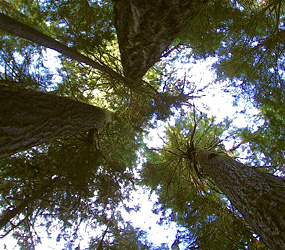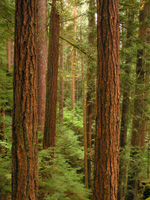Lowland Forests

View up into old growth Douglas-fir canopy.
Imagine a living organism 30 stories tall and wider than two parking spaces. It is humbling to stand amidst such giants in the ancient forests of Olympic National Park. The Olympic Peninsula lowlands, with their mild climate, deeper soils and generous rainfall grow world record trees. These old survivors record centuries of history in their massive trunks.
What is old growth forest?
Though there are old groves of subalpine firs, and huge trees amid the temperate rain forest in the park, when scientists use the term old growth, they are usually referring to Douglas-fir/western hemlock forests with these characteristics:
Value of the Forest
What is the value of a tree, a forest? A tree might have so many board feet and thus be worth a certain amount to a homebuilder. Or a tree might be the only in the area with branches wide enough for a marbled murrelet to lay her egg on. Or a group of trees might anchor the soil on a slope above a town, or above a drinking water supply. Or a tree and its neighbors might filter the air, taking in carbon dioxide we’ve added to our atmosphere and helping to store it harmlessly, locked up in its woody tissue. In Olympic, you can walk the lowland forest and answer that question for yourself.
Where To See Lowland, Old Growth ForestsExplore the Sol Duc or Elwha valleys, or trails at Lake Crescent. Or visit the forest around Staircase in the southeast corner of the park.

Old growth forest with deeply furrowed bark on older Douglas-firs and lacy western hemlocks below.
Common TreesDouglas-fir – Pseudotsuga menziesii
Western hemlock – Tsuga heterophylla Western redcedar – Thuja plicata Grand fir – Abies grandis Sitka spruce – Picea sitchensis (primarily westside rain forests)
Common Shrubs
Coast red elderberry – Sambucus racemosa Huckleberries – Vaccinium sp.Ocean spray - Holodiscus discolor Oregon grape – Berberis nervosa Salal – Gaultheria shallon
Common Understory PlantsBleeding heart – Dicentra formosaViolets – Viola sp.
Star flower – Trientalis borealis Sword fern – Polystichum munitum Trillium – Trillium ovatum Twinflower – Linnaea borealisVanillaleaf – Achlys sp.Youth-on-age – Tolmeia menziesii |
No comments:
Post a Comment